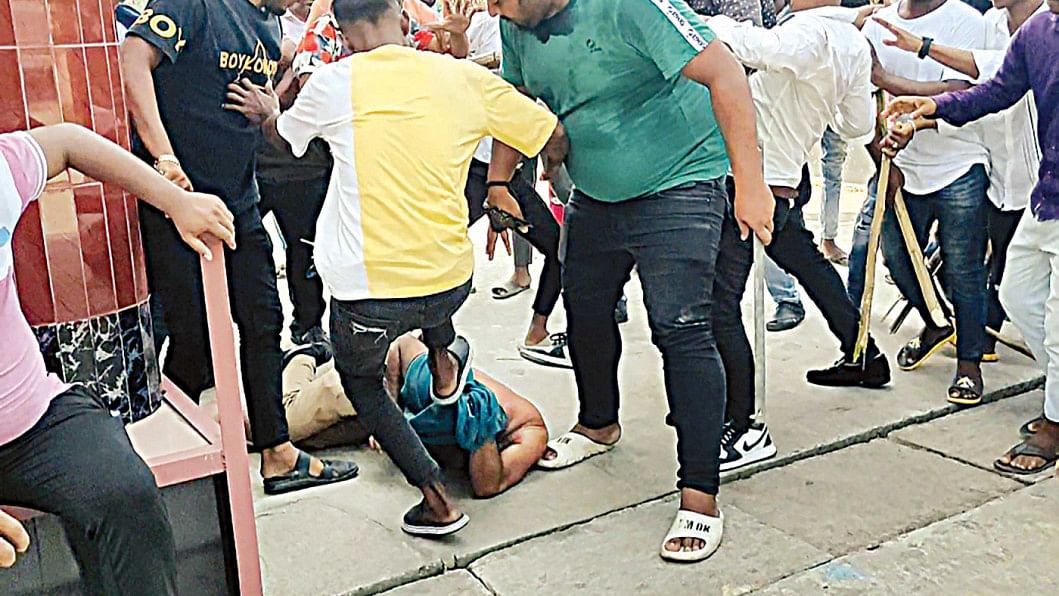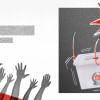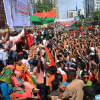Excessive force against protesters can’t be justified

Over the last few weeks, newspapers have been publishing two contrasting pictures. One shows the activists of the ruling Awami League carrying locally-made arms in a display of muscle power and dominance in the political sphere, and the other is of angry BNP supporters holding protests in larger numbers. In never-ending confrontational politics, such contrasting images are not unusual, but the difference in policing those public gatherings is quite shocking.
Though our police are supposed to be neutral and sincere in maintaining peace and order, their actions and inactions could not be more partisan. Reports suggest that, over the fortnight, there were clashes in more than 70 places across Bangladesh. In most cases, armed supporters of the ruling party attacked BNP activists where police remained mere spectators, but in other incidents, they too became involved in the violence – often with brutal and excessive force. The worst, however, is the shocking revelation that a member of the Detective Branch (DB) used an unauthorised rifle to open fire at a BNP crowd in Narayanganj. Samakal quoted an unnamed official who claimed that the alleged offending DB official was not supposed to own this, since the force only gave him a pistol. Narayanganj ASP Tariqul Islam told the newspaper that police usually deploys shotguns for riot control, not rifles. Thereby, the picture showing the DB man firing a Chinese rifle raises many serious questions, and such grievous violation of rules needs to be investigated.
The brutal excess in policing is also cause for grave concern. The same Samakal report quoted another ASP, Amir Khasru, saying that police had used more than 700 rounds of bullets in Narayanganj, which resulted in the death of BNP activist Shaon and left more than 250 people injured, including 25 with gun wounds. The BNP rally was organised to celebrate their founding anniversary, and images published in newspapers show little signs of resistance from its participants, who seem largely unarmed, as police charge to disperse the crowd. It was quite a contrast to the images of armed ruling party supporters displaying their prowess on the streets and not giving an inch to the opposition.
A similar kind of policing happened in Bhola too, where sadly two people were killed. It happened in Narsingdi and Chittagong as well, and all these incidents took place during the ongoing opposition campaign to protest against price hikes, energy crisis and economic woes. The trend that is emerging in policing protests clearly shows unwarranted and disproportionate use of force – deadly fire power, in particular.

Rules on regulating lawful and unlawful assemblies dictate that opening fire on demonstrators should be the last resort, used only when there is no other way to save lives and properties. None of the recent protests suggest any unruly behaviour, like wanton destruction of public property. There are stricter procedures for dispersing any authorised or pop-up protest, and if and when dispersal orders are not followed by protesters, there are ways to tackle the offenders, including suing them for violating lawful orders. Police are supposed to show maximum restraint even when they are provoked.
Chapter IX (Articles 127-132) of the Code of Criminal Procedure, 1898 clearly defines how to deal with unlawful assemblies, including the usage of civil and military powers, in which the principle is, even after issuance of an order, a law enforcement officer shall "obey such requisition in such manner as he thinks fit, but in so doing he shall use as little force, and do as little injury to person and property, as may be consistent with dispersing the assembly and arresting and detaining such persons."
In addition, about the use of firearms to disperse an unlawful assembly, the Police Regulations, Bengal stipulates in Clause 153 (C) that "i) An order to fire upon a crowd should be regarded as an extreme measure to which recourse should be had only in the last resort when it is absolutely necessary for the defence of life or property or when a magistrate, an officer-in-charge of a police station or (a) police officer superior in rank to such officer considers it impossible to disperse a mob by any other means; ii) Before an order is given to fire upon a crowd, the magistrate or, if no magistrate is present, the police officer in command shall give a lull and sufficient warning to the rioters that they will be fired upon if they do not disperse immediately; iii) All ranks engaged in the suppression of a riot or in the dispersal of a riotous assembly must await the orders of a magistrate, an officer-in-charge of a police station or a police officer superior in rank to such officer before firing."
Human rights standards have led to forces in many democracies ditching even water cannons in dealing with violent crowds. Aggression in protests in many capitals are not softer by any definition. Imagine if police had opened fire during the January 6 storming of the Capitol in Washington, DC, which caused the deaths of two police officers.
In Bangladesh, law enforcement forces seem to be heading in the opposite direction and becoming more trigger happy. The government needs to act to reverse the trend promptly, as it has done in dealing with police excesses against a faction of Chhatra League in Barguna. Civic rights groups, too, should speak out against unwarranted use of disproportionate force to suppress protests.
Kamal Ahmed is an independent journalist and writes from London, UK. His Twitter handle is @ahmedka1

 For all latest news, follow The Daily Star's Google News channel.
For all latest news, follow The Daily Star's Google News channel. 










Comments